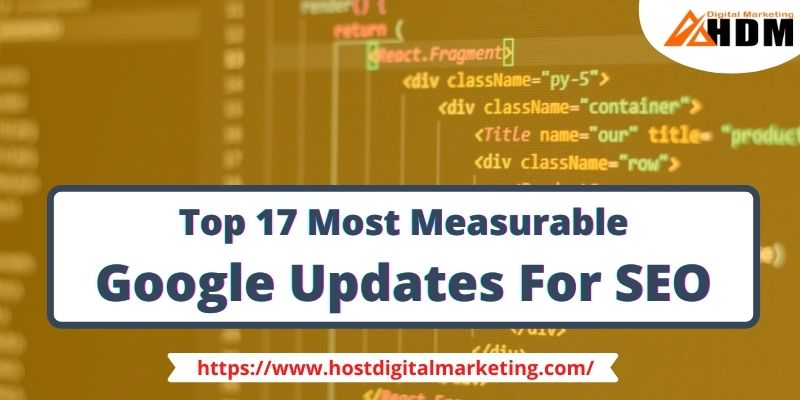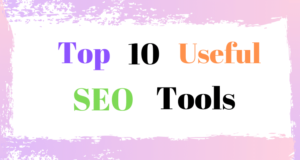Table of Contents
- 1 1. Google Updates For SEO – PANDA:
- 2 2. Google Updates For SEO – PENGUIN:
- 3 3. Google Updates For SEO – HUMMINGBIRD:
- 4 4. Google Updates For SEO – MOBILE:
- 5 5. Google Updates For SEO – PIGEON:
- 6 6. Google Updates For SEO – BRANDY:
- 7 7. Google Updates For SEO – AUSTIN:
- 8 8. Google Updates For SEO – POSSUM:
- 9 9. Google Updates For SEO – RANK BRAIN:
- 10 10. Google Updates For SEO – PIRATE:
- 11 11. Google Updates For SEO – FLORIDA:
- 12 12. Google Updates For SEO – FRED:
- 13 13. Google Updates For SEO – SPEED:
- 14 14. Google Updates For SEO – MEDIC:
- 15 15. Google Updates For SEO – BERT:
- 16 16. Google Updates For SEO – FEATURED SNIPPET:
- 17 17. GOOGLE MAY 2020 CORE ALGORITHM UPDATE:
- 18 4 WAYS TO MAKE SURE YOU HAVE HIGH-QUALITY USER EXPERIENCE
Well, you might know Google keeps on updating and gives daily news updates for SEO.
SEO is Search Engine Optimization. It refers to optimizing your online content to increase the traffic on your website. SEO is a process that helps to improve online presence and visibility on search engines.
Earlier, Google made very few updates in a year.
Still, nowadays, you may experience there are thousands of updates in a year. Some changes are noticeable, whereas few updates are unnoticed.
It takes a lot of effort to update the old content and increase the ranking of your website.
Well, we all know to get the first position is not difficult but to retain that position is difficult.
And there are a lot of competitors in today’s world. To retain your position in the market, you need to keep on updating your website and make it SEO-friendly.
Listed below are the SEO factors to Boost Rankings of Website:
- Optimized Content: Images, video, and text on the website should be optimized and relevant.
- Mobile-Friendly Design: Google now prioritizes mobile-friendliness websites. Your website is formatted to deliver a great user experience on a mobile device.
- Fast page load speed: The Website’s ideal load time is under 3 seconds, and the faster, the better.
- Linking: Develop a Link building strategy to encourage other websites to link to yours.
Google likes shaking things up to make it easier for users to find what they want in less time. Each time they change the algorithm, rankings get scrambled. It’s kind the first shall be the last scenario.
Below is the list of Google algorithms and a brief explanation of every google update.
Up to 90% OFF Shared & WordPress hosting plans! Web Hosting + Domain starting from 1.99$ Don’t forget your coupon code NY2021 for an additional 7% discount on web hosting. The link is here – https://www.hostg.xyz/SH4vr
1. Google Updates For SEO – PANDA:
Panda Google algorithm says that Google down the ranking of those websites which have keyword stuffing or write plagiarised content.
This algorithm helps Google to lower the ranking of low-quality content and increase the ranking of those websites and articles which are of really good quality.
If your content is repeated and not adding value as well as not providing unique content, then your content will be detected in the Panda algorithm filter.
If you suspect that your content is plagiarized from other sources, then you can detect the duplicated content from Copyscape and remove it.
2. Google Updates For SEO – PENGUIN:
Penguin Google update launched on 24th April 2012.
This update detects those sites that have spam or irrelevant links or over-optimized their content.
The algorithm’s objective is to decrease the rank of those sites whose backlinks look unnatural and violate Google’s Webmaster Guidelines.
3. Google Updates For SEO – HUMMINGBIRD:
For controlling the keyword, stuffing google rolled out a hummingbird update in mid-2013.
Hummingbird algorithm works on user’s intent & it’s a real-time algorithm, launched on 22nd August 2013.
The algorithm change especially affects the Knowledge graph.
If you are using Google search by your voice, it has enhanced your understanding of your context.
For example, You have asked what the nearest restaurant is? And after that, you have asked what its reviews are? Then Google will understand you are asking the reviews of the restaurant.
It is not a penalty-based update. Its purpose is to serve the best results for specific queries in Speed & Accuracy.
Google Hummingbird is mainly responsible for giving the answers to your conversational queries instead of keyword-based queries.
This algorithm makes the search easier, quicker, and intuitive.
4. Google Updates For SEO – MOBILE:
Today, Google ranks all those websites which are mobile-optimized and have better mobile usability.
This algorithm was launched on 21st April 2015.
5. Google Updates For SEO – PIGEON:
The pigeon algorithm launched on 24th July 2014 and offers better local search results with a better organic presence in the market.
It improves the quality of local searches and provides more relevant results to the user.
This idea of promoting local businesses and increasing their ranking in the search results is very beneficial for all small businesses with better visibility in traditional search.
To improve the rankings of local businesses, Google enhanced the hundreds of ranking signals for Google maps and Google Search.
After launching the Pigeon algorithm, Google Search and Google maps have a uniform appearance and functionality.
Purpose of searching for accurate local results.
An algorithm is based on improving rankings based on distance and location.
6. Google Updates For SEO – BRANDY:
It was released between late January and mid-February 2004.
Latent Semantic Indexing helping the search engine to understand a page conceptually based on language pattern.
It is highly impacted by synonyms and word associations.
7. Google Updates For SEO – AUSTIN:
It was released in January 2004.The main purpose of this algorithm was to remove many spam sites from the Google Index.
Sometimes websites use text which is visible by search engines, not only by the user. They are using a white font color.
It is majorly focusing on removing those websites which have been using poor SEO tactics.
8. Google Updates For SEO – POSSUM:
Possum Google algorithm update impacts on Local Finder & Local Packs Result in Google.
A study shows Google’s Possum update changed 64% of local SERPs!!
9. Google Updates For SEO – RANK BRAIN:
Rank Brain Algorithem Alog is paying very close attention to how you interact with search results. Specifically, it is looking at Dwell Time, Bounce Rate, Pogo Sticking.
So let’s discuss what Dwell time is! When a user spends time on any of the pages of a website and returns back to the SERPs, that duration is known as Dwell time.
The next one is the Bounce Rate, which is calculated in percentage. Bounce rate is known as when users leave a webpage and do not click on any of the links given on the website or make any transaction.
Pogo sticking is when a search engine user visits several different search results to find a result that satisfies their search query.
10. Google Updates For SEO – PIRATE:
Released in August 2012, Pirate is an update to Google’s core algorithm that penalizes websites with too many copyright infringements filled via the Digital Millennium Copyright Act (DCMA) reports system.
11. Google Updates For SEO – FLORIDA:
Google launched a new update on 16th November 2003, known as the Florida Google Algorithm.
This algorithm mainly affects e-commerce websites and product affiliates.
Top ranking e-Commerce websites crash down after the new algorithm of Google.
Sites that have keyword stuffing, hidden links, invisible text rank down on the SERPs.
After Florida, companies start making high-quality content sites that are very useful for users.
12. Google Updates For SEO – FRED:
Google Fred algorithm is a penalty to those websites which aren’t content-driven.
It targets websites using black-hat tactics.
Sites with a high amount of irrelevant ads and with poor backlinking from low domain credentials are highly affected by this Google algorithm.
13. Google Updates For SEO – SPEED:
This algorithm is designed mainly for mobile search, and only pages that deliver the slowest experience to users are impacted by this algorithm. The ranking of those websites that have low-speed loading is impacted by this update.
14. Google Updates For SEO – MEDIC:
Medic is another Google algorithm that was launched on 1st August 2018 and mainly focuses on quality issues like slow loading time and plagiarised content. The ranking of those websites falls down who have low EAT, and increase the ranking of those which have high EAT.
15. Google Updates For SEO – BERT:
BERT stands for Bidirectional Encoder Representation from Transformers.
Google has rolled out another major update named “BERT” at the end of October 2019.
Now search intent will play a big role. BERT improves the user experience by better understanding the search query.
This update will affect those sites which have thin and low-quality content with irrelevant keywords.
16. Google Updates For SEO – FEATURED SNIPPET:
If your website is performing well on SERPs, and some web pages are ranking at the top, then all of those best-performing pages should be optimized for featured snippets. In terms of winning featured snippets, you need to strategize the content for some of the various on-page SEO elements.
Benefits of Featured Snippets:
- Higher Click-Through Rate.
- Higher Brand Authority.
- Audience Behaviour Insights.
17. GOOGLE MAY 2020 CORE ALGORITHM UPDATE:
Your website ranking drops because of this update. Want to know why this happens to your website? Google May 2020 Core Algorithm focuses on content.
Websites that did not update their content for a long time, their ranking falls due to the new algorithm update.
Websites regularly updating their content make unique, and new content from a long time get promoted from a higher ranking in Google Search Engines.
Start working on your content and create something new and unique to get out of this and find your ranking again.
4 WAYS TO MAKE SURE YOU HAVE HIGH-QUALITY USER EXPERIENCE
If your users don’t love you, Google won’t be either. In the following years, everything will revolve around user-experience. Google is making sure that it works on what consumers want.
- CHECK YOUR SPEED: That is the number one priority. If you cannot grab the attention of a user in 5 to 7 seconds, you have lost your customers. There are multiple tools to check your speed.
- USE HEATMAP CRAZY EGG (TOOL): What a heat map does is, tells you where exactly the user is clicking on your website. You will get clarity on what attracts the user the most.
- CHECK YOUR DA: DA is Domain Authority. It means how much value your website URL has on the internet. DA 1 is for a new website, and 14-20 being average for a startup.
- MOBILE COMPATIBILITY: Gone are the days when the desktop version was a trend, now mobile-site is the new trend. Even if your desktop version is average, make sure your mobile site is WOW!
Feature Reading
- MilesWeb Review: Is Managed VPS Hosting Worth your Time & Money?
- What is a 404 Error Page? – How to Find and Fix?
- 6 Major Difference Between Website and Web Portal!
- Difference Between – What is Blog & What is Website?
- What Is A Blog? A Complete Overview of Blog!




